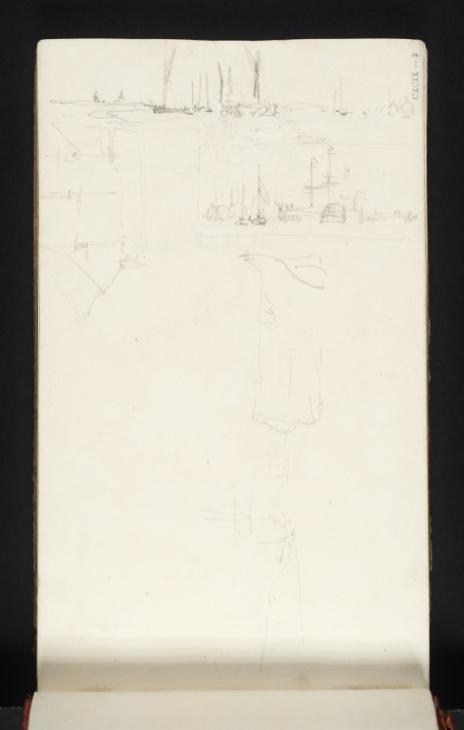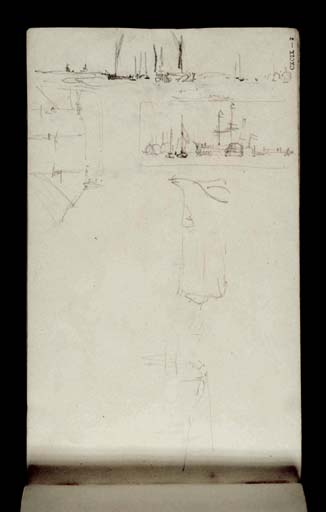Joseph Mallord William Turner Beached Ships on the River Medway c.1821
Image 1 of 2
Joseph Mallord William Turner,
Beached Ships on the River Medway
c.1821
Joseph Mallord William Turner 1775–1851
Folio 2 Recto:
Beached Ships on the River Medway c.1821
D17367
Turner Bequest CXCIX 2
Turner Bequest CXCIX 2
Pencil on white wove paper, 190 x 112 mm
Stamped in black ‘CXCIX – 2’ top right, ascending vertically
Stamped in black ‘CXCIX – 2’ top right, ascending vertically
Accepted by the nation as part of the Turner Bequest 1856
References
1909
A.J. Finberg, A Complete Inventory of the Drawings of the Turner Bequest, London 1909, vol.I, p.607, CXCIX 2, as ‘Ships’.
As identified by Finberg, this page pursues the shipping theme evident throughout the sketchbook.1 The Medway identification is suggested here in light of the volume’s overriding topographic focus. With the page turned vertically, a panoramic prospect stretches across the top of the page. It displays unmanned boats along the bank. The masts stand tall, projecting into the blank space of sky, and dark, angular scribbles mark pockets of shadow across the clusters of wooden hulls. At far left some reasonably flat topography is evident, and two structures, the leftmost a windmill, are visible on the horizon.
Beneath this full-width panorama, on the right, Turner marks three edges of a box around another sketch of vessels. This separates the miniature scene from the rest of the sheet, although thematically it remains consistent. Here, Turner observes docked ships. A particularly large boat is positioned at centre. Its tall masts are the highest points in the drawing, and it is shown lengthways, in profile, while the smaller boats meet Turner’s gaze head-on. At far right a brief sliver of topography is indicated.
At top left, this time made with the page turned horizontally according to the foliation of the sketchbook, a more expansive drawing of a large vessel is delineated. The handling is light and quick, although the shape of the hull is clear and distinctive, and the masts and brief rigging confidently rendered.
Again with the page used horizontally, according to the sketchbook’s foliation, Turner makes a final drawing, or group of drawings, across the middle of the remaining blank space. At far left a portion of a coastal headland is evident. To the immediate right of this a ship is lightly indicated, its masts and rigging rendered as a brief grid. This prospect may extend further towards the right, however at the centre of the page the lines become confused and their meaning unclear.
Maud Whatley
January 2016
How to cite
Maud Whatley, ‘Beached Ships on the River Medway c.1821 by Joseph Mallord William Turner’, catalogue entry, January 2016, in David Blayney Brown (ed.), J.M.W. Turner: Sketchbooks, Drawings and Watercolours, Tate Research Publication, February 2017, https://www


